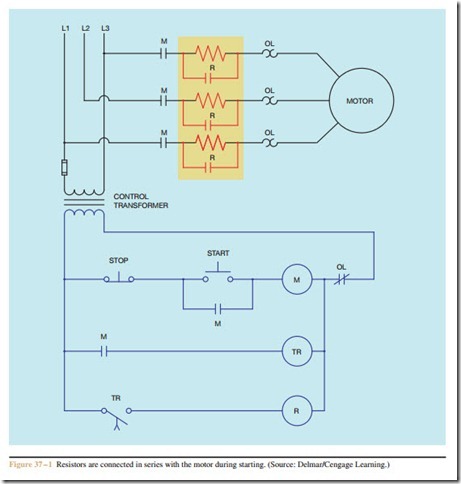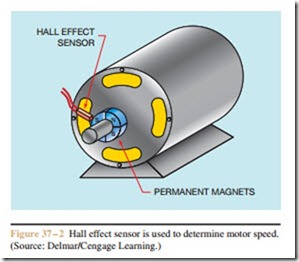There are conditions where it is not possible to start a motor across the line due to excessive starting current or excessive torque. Some power systems are not capable of providing the high initial currents produced by starting large horsepower motors. When this is the case, some means must be employed to reduce the amount of starting current. Two of the most common methods are resistor starting and reactor starting. Although these two methods are very similar, they differ in the means used to reduce the amount of starting current.
Resistor Starting
Resistor starting is accomplished by connecting resistors in series with the motor during the starting period (Figure 37 – 1). When the Start button is pressed, motor starter coil M energizes and closes all M contacts. The three M load contacts connect the motor and resistors to the line. Since the resistors are connected in series with the motor, they limit the amount of in-rush cur- rent. When the M auxiliary contact connected in series with coil TR closes, the timer begins its timing sequence. At the end of the time period, timed contact TR closes and energizes contactor R. This causes the three R contacts connected in parallel with the resistors to close. The R contacts shunt the resistors out of the line and the motor is now connected to full power.
The circuit in Figure 37 – 1 uses time delay to shunt the resistors out of the circuit after some period of time. Time delay is one of the most popular methods of determining when to connect the motor directly to the power line because it is simple and inexpensive, but it is not the only method. Some control circuits sense
motor speed to determine when to shunt the resistors out of the power line (Figure 37 – 2). In the illustration, permanent magnets are attached to the motor shaft, and a Hall effect sensor determines the motor speed. When the motor speed reaches a predetermined level, contactor R energizes and shunts the resistors out of the line (Figure 37 – 3).
Another way of determining when to shunt the resistors out of the circuit is by sensing motor current. Current transformers are used to sense the amount of motor current (Figure 37 – 4). In this circuit, the current sensor contacts are normally closed. When the motor starts, high current causes the sensor contacts to open. An on-delay timer provides enough time delay to permit the motor to begin starting before contactor coil R can energize. This timer is generally set for a very short time delay. As the motor speed increases, the current drops. When the current drops to a low enough level, the current sensor contact re-closes and permits contactor R to energize.

